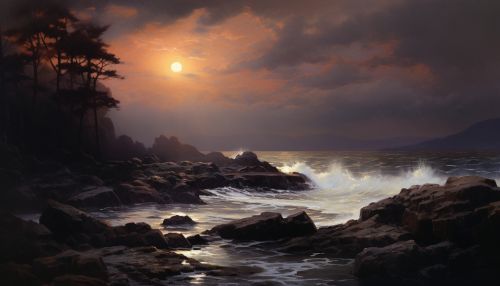Contrast
Definition and Importance
Contrast is a principle in visual arts that refers to the arrangement of opposite elements (light vs. dark colors, rough vs. smooth textures, large vs. small shapes, etc.) in a piece to create visual interest, excitement, and drama. The concept of contrast is rooted in the color theory, which is a practical guidance to color mixing and the visual effects of specific color combinations.


In a broader sense, contrast is not only limited to visual arts. It is a significant concept in various fields such as literature, music, photography, and design. Contrast helps in highlighting key elements and guiding the viewer's or reader's attention to the areas of interest. It is a powerful tool that can be used to improve the effectiveness of a design or a piece of art.
Contrast in Visual Arts
In visual arts, contrast is used to differentiate elements and create variety. It can be achieved through the manipulation of colors, shapes, sizes, and even textures. The use of contrast in visual arts can be traced back to the early days of cave paintings, where primitive humans used naturally occurring pigments to create contrast and depict their daily life and rituals.
Color Contrast
Color contrast refers to the difference in color properties such as hue, value, and saturation. It is one of the most common types of contrast used in visual arts. Color contrast can be achieved by placing colors with different properties next to each other. For example, placing a light color next to a dark color creates a strong contrast, while placing two colors with similar values next to each other results in a low contrast.
Shape and Size Contrast
Shape and size contrast involves the use of different shapes and sizes to create a sense of depth and interest. This can be achieved by juxtaposing large and small shapes, or using different shapes in a composition. This type of contrast is commonly used in graphic design and architecture.
Texture Contrast
Texture contrast involves the use of different textures to create a sense of depth and interest. This can be achieved by juxtaposing rough and smooth textures, or using different textures in a composition. This type of contrast is commonly used in interior design and fashion design.
Contrast in Literature
In literature, contrast is a rhetorical device that writers use to set off or relate different characters or themes. This is often done to highlight the differences between two or more elements. For example, a writer may contrast a main character's strength with a secondary character's weakness to highlight the main character's superiority.
Contrast in literature can also be used to create tension, develop characters, and drive the plot. For example, the contrast between a character's actions and their stated intentions can create dramatic irony, a literary device that adds layers of meaning to a story.
Contrast in Music
In music, contrast is used to differentiate sections of a piece and create variety. This can be achieved through the manipulation of melody, rhythm, dynamics, and even timbre. The use of contrast in music can be traced back to the early days of classical music, where composers used contrast to create tension and release, and to highlight different sections of a piece.
Contrast in Photography and Design
In photography and design, contrast is used to differentiate elements and create visual interest. This can be achieved through the manipulation of colors, shapes, sizes, and even textures. High contrast images tend to be more dynamic and visually interesting, while low contrast images tend to be more subtle and calming.
